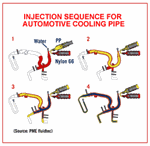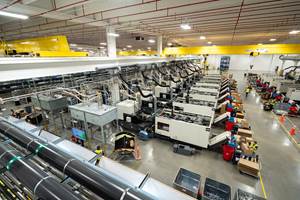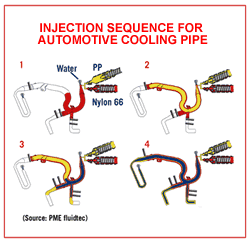Sequential Hard/Soft Injection Molding with Water Assist
In 2004, the value of pairing two-material injection with water assist was demonstrated in production of two-layer automotive pipes and ducts (see Learn More). Further potential for this combination of advanced techniques in sequential injection of hollow automotive parts with rigid and flexible sections is being developed at the German Institute of Plastics Processing (known as the IKV). Water injection technology (WIT) was first developed at the IKV in the 1990s.
TWO SEQUENTIAL APPROACHES
At the Institute’s recent 24th International Colloquium in Aachen, engineering graduate student Andreas Neuss presented the results of his research on sequential hard/soft injection with water assist. Potential applications are air intakes, cooling ducts, and oil lines, as well as non-automotive uses such as clothes-washer lines. Such products have been produced with 3D sequential coextrusion blow molding, but Neuss said such equipment is, in many cases, more expensive than a multicomponent injection machine with water assist.
Neuss examined two alternative methods. The “fluid-bubble transfer” process involves simultaneous injection of the soft component in the center of the duct and of the hard component at either end of the part. Water is then injected from one end. The melt flow front of the hard component at the start of the pipe is forced further by the water and penetrates into the soft segment a short distance. Subsequently, the water passes from the hard segment through the soft segment and then through the hard segment on the other side.
The second approach, called the “melt breakthrough” process, injects the hard component into the center of the duct and the soft component at just one end. The melt front of the soft component encounters the hard component in center of the duct, penetrates it, and breaks through at the opposite side. Then water is injected at one end. In this version, the water flow front remains inside the soft-segment material, which “breaks through” the hard segment and continues beyond it. This results in a hollow two-layer structure at the rigid portion of the duct.
PROCESSING & MATERIALS
Neuss used a 220-ton Ferromatik Milacron K-Tec injection machine with a horizontal barrel to inject the hard component and a smaller vertical barrel to inject the soft component. The materials used were polypropylene for the hard segment and a TPO, TPV, or styrenic TPE as the soft segment. In ongoing research, Neuss will investigate more commercially viable combinations such as glass-reinforced nylon 12 and a flexible nylon 12, PPS with a flexible nylon, or PBT and a copolyester TPE. Materials would have to be chosen for good adhesion to each other and suitability for WIT.
For the fluid-bubble transfer process, Neuss left an air gap between the hard-segment and soft-segment melts, so as to leave room for material that is displaced when water is injected. He also noted that this method produces a transition zone where some of the hard-segment melt penetrates into the soft-segment material, creating a two-layer zone. This transition zone is shortest when the viscosity of the hard-segment melt (where the water bubble is contained) is lower than that of the soft-segment melt into which the water bubble is transferred. Water seeks the easiest path, Neuss explained, so it tends to remain within the most fluid melt. This results in the most reproducible transition zones with least turbulence and mixing.
With the melt-breakthrough process, it is desirable to have the viscosity of the soft-segment melt lower than that of the hard-segment melt that must be penetrated by the other melt stream. This results in short and reproducible rigid segments.
Related Content
LS Mtron’s Outsized NPE2024 Presence Jump-Starts Ambitious North American Market Goals
The Korean maker of injection molding machines featured eight machines in its nearly 14,000-square-foot booth with additional presses at Yushin and Incoe’s booths, as it targets 20% market share.
Read MoreIPEX Opens Injection Molding Facility in North Carolina
The pipe and fittings manufacturer’s new 200,000-square-foot facility represents a $200 million investment and will create 150 jobs.
Read MoreDigital Manufacturing: Two Medical Molders Embrace Industry 4.0
‘Digitalization’ and ‘connectivity’ are loaded terms—shorthand for a whole new way of doing ´óĎó´«Ă˝. It can’t be accomplished in one go. But two Midwest molders in the sensitive medical field are already feeling the benefits of their initial steps in that direction.
Read MoreMedical and Molding Elite
When Jeff Smith received a notice evicting his promising ´óĎó´«Ă˝ out of his house, it could have been the end of Elite Biomedical Solutions’ and Elite Precision Plastics’ stories before they really got started, instead it was just the beginning.
Read MoreRead Next
Two-Material Automotive Part Is Cored Out with Water
A three-stage injection process involving nylon, polypropylene, and water assist was demonstrated at the recent K 2004 show in Dusseldorf, Germany.
Read MoreFor PLASTICS' CEO Seaholm, NPE to Shine Light on Sustainability Successes
With advocacy, communication and sustainability as three main pillars, Seaholm leads a trade association to NPE that ‘is more active today than we have ever been.’
Read MoreMaking the Circular Economy a Reality
Driven by brand owner demands and new worldwide legislation, the entire supply chain is working toward the shift to circularity, with some evidence the circular economy has already begun.
Read More













